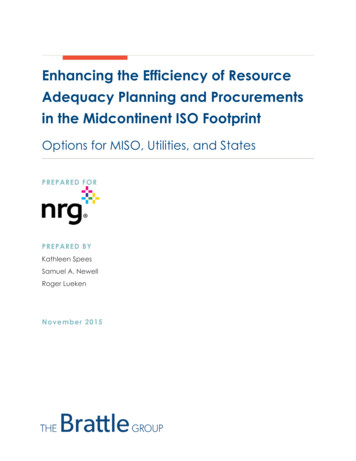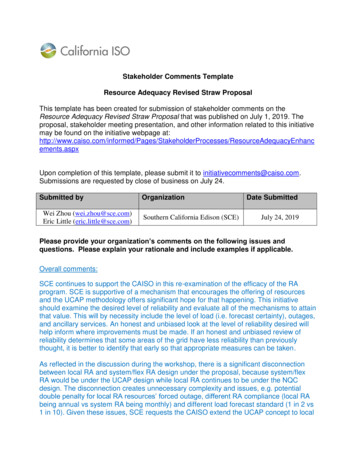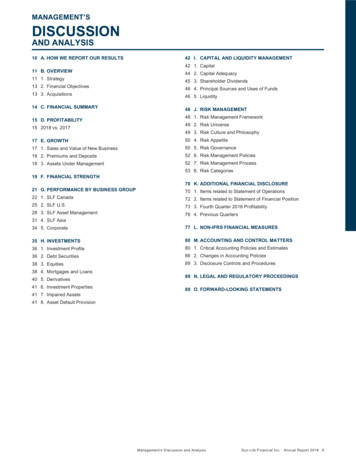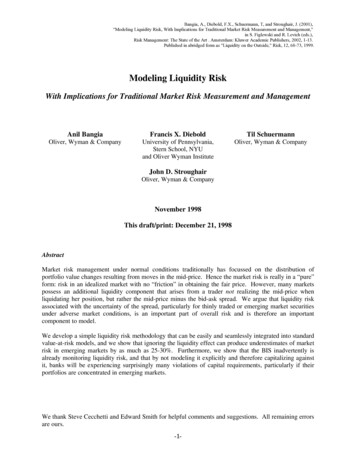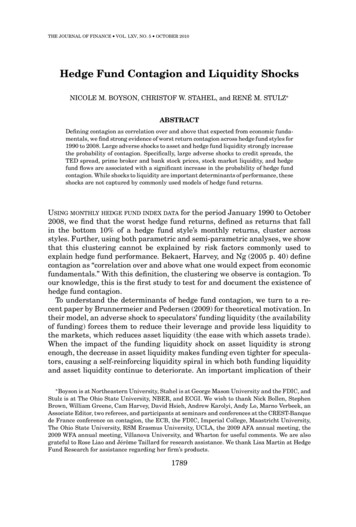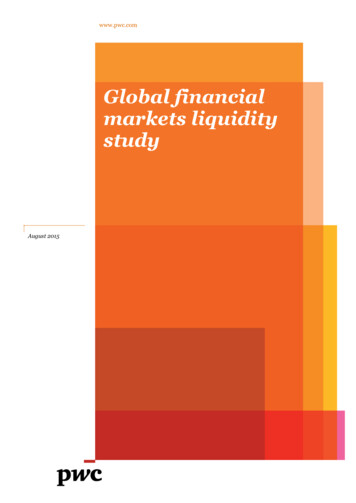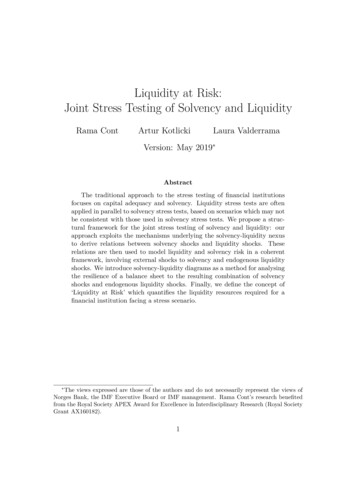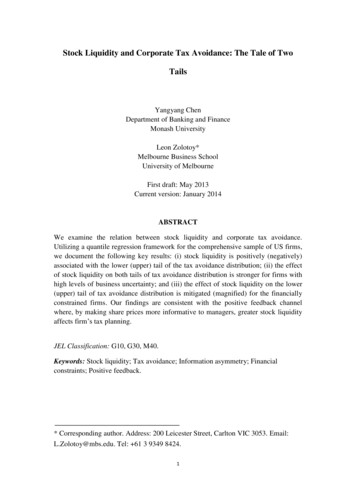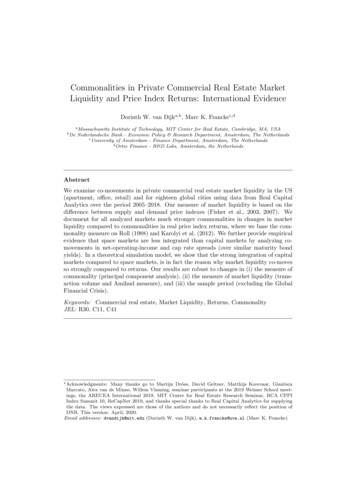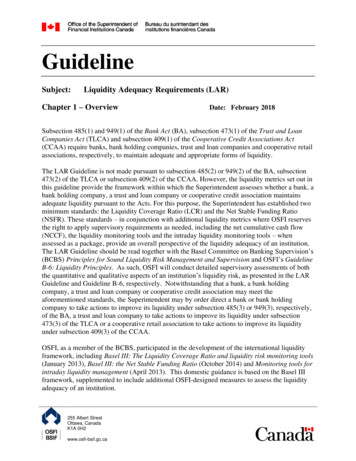
Transcription
GuidelineSubject:Liquidity Adequacy Requirements (LAR)Chapter 1 – OverviewDate: February 2018Subsection 485(1) and 949(1) of the Bank Act (BA), subsection 473(1) of the Trust and LoanCompanies Act (TLCA) and subsection 409(1) of the Cooperative Credit Associations Act(CCAA) require banks, bank holding companies, trust and loan companies and cooperative retailassociations, respectively, to maintain adequate and appropriate forms of liquidity.The LAR Guideline is not made pursuant to subsection 485(2) or 949(2) of the BA, subsection473(2) of the TLCA or subsection 409(2) of the CCAA. However, the liquidity metrics set out inthis guideline provide the framework within which the Superintendent assesses whether a bank, abank holding company, a trust and loan company or cooperative credit association maintainsadequate liquidity pursuant to the Acts. For this purpose, the Superintendent has established twominimum standards: the Liquidity Coverage Ratio (LCR) and the Net Stable Funding Ratio(NSFR). These standards – in conjunction with additional liquidity metrics where OSFI reservesthe right to apply supervisory requirements as needed, including the net cumulative cash flow(NCCF), the liquidity monitoring tools and the intraday liquidity monitoring tools – whenassessed as a package, provide an overall perspective of the liquidity adequacy of an institution.The LAR Guideline should be read together with the Basel Committee on Banking Supervision’s(BCBS) Principles for Sound Liquidity Risk Management and Supervision and OSFI’s GuidelineB-6: Liquidity Principles. As such, OSFI will conduct detailed supervisory assessments of boththe quantitative and qualitative aspects of an institution’s liquidity risk, as presented in the LARGuideline and Guideline B-6, respectively. Notwithstanding that a bank, a bank holdingcompany, a trust and loan company or cooperative credit association may meet theaforementioned standards, the Superintendent may by order direct a bank or bank holdingcompany to take actions to improve its liquidity under subsection 485(3) or 949(3), respectively,of the BA, a trust and loan company to take actions to improve its liquidity under subsection473(3) of the TLCA or a cooperative retail association to take actions to improve its liquidityunder subsection 409(3) of the CCAA.OSFI, as a member of the BCBS, participated in the development of the international liquidityframework, including Basel III: The Liquidity Coverage Ratio and liquidity risk monitoring tools(January 2013), Basel III: the Net Stable Funding Ratio (October 2014) and Monitoring tools forintraday liquidity management (April 2013). This domestic guidance is based on the Basel IIIframework, supplemented to include additional OSFI-designed measures to assess the liquidityadequacy of an institution.255 Albert StreetOttawa, CanadaK1A 0H2www.osfi-bsif.gc.ca
Where relevant, the Basel III paragraph numbers are provided in square brackets at the end ofeach paragraph referencing material from the Basel III framework. Some chapters includeboxed-in text (called OSFI Notes) that set out how certain requirements are to be implementedby Canadian banks, bank holding companies, trust and loan companies and cooperative creditassociations, collectively referred to as ‘institutions’.Banks/BHC/T&L/Retail AssociationsFebruary 2018OverviewChapter 1 - Page 2
Liquidity Adequacy RequirementsThe Liquidity Adequacy Requirements (LAR) for banks, bank holding companies, trust and loancompanies and cooperative retail associations are set out in six chapters, each of which has beenissued as a separate document. This document, which contains Chapter 1 – Overview, should beread together with the other LAR chapters which include:Chapter 1OverviewChapter 2Liquidity Coverage RatioChapter 3Net Stable Funding RatioChapter 4Net Cumulative Cash FlowChapter 5Liquidity Monitoring ToolsChapter 6Intraday Liquidity Monitoring ToolsBanks/BHC/T&L/Retail AssociationsFebruary 2018OverviewChapter 1 - Page 3
Chapter 1 – OverviewTable of Contents1.1. Objective . 51.2. Scope of application . 51.3. Overview of the individual liquidity metrics . 61.4. Requirements associated with the metrics . 81.5. Frequency of calculation and regulatory reporting timeline. 9Banks/BHC/T&L/Retail AssociationsFebruary 2018OverviewChapter 1 - Page 4
Chapter 1 – Overview1.1.Objective1.Outlined below is an overview of liquidity adequacy requirements for banks, federallyregulated trust or loan companies, cooperative retail associations, and for bank holdingcompanies incorporated or formed under Part XV of the Bank Act, collectively referred to as‘institutions’.2.Parts of this chapter draw on the Basel Committee on Banking Supervision’s (BCBS)Basel III liquidity framework, which encompasses Basel III: The Liquidity Coverage Ratio andliquidity risk monitoring tools – published in January 2013, Basel III: the Net Stable FundingRatio – published October 2014, and Monitoring tools for intraday liquidity management –published in April 2013. For reference, the Basel text paragraph numbers that are associated withthe text appearing in this chapter are indicated in square brackets at the end of each paragraph1.3.This guideline contains the methodologies underpinning a series of liquidity metrics thatare used by OSFI to assess the liquidity adequacy of an institution. OSFI will evaluate theperformance of an institution’s liquidity metrics both as a package and individually whendetermining its overall assessment of an institution’s liquidity adequacy. In addition, theliquidity metrics presented in this guideline will be supplemented by detailed supervisoryassessments of other aspects of an institution’s liquidity risk management framework in line withthe BCBS Sound Principles2 and OSFI’s Guideline B-6: Liquidity Principles3. This is to ensurethat the aspects of the OSFI’s liquidity guidelines are well engrained in institutions’ internalpractices; for example that institutions should incorporate liquidity costs, benefits and risks intheir internal pricing, in line with OSFI Principle 10 in Guideline B-6.1.2.Scope of application4.Unless otherwise noted in the detailed discussion of the individual liquidity measures (seeChapter 2 to Chapter 6), these liquidity adequacy requirements apply on a consolidated basis andapply to all institutions. The consolidated entity includes all subsidiaries and branches exceptinsurance subsidiaries, as set out in Section 1.1 of OSFI’s Capital Adequacy Requirements(CAR) Guideline4.1234Following the format: [BCBS Jan 2013, para X], [BCBS Jan 2014, para X] and [BCBS Apr 2013, para ro/gdn-ort/gl-ld/Pages/CAR chpt1.aspx.Banks/BHC/T&L/Retail AssociationsFebruary 2018OverviewChapter 1 - Page 5
OSFI NotesFederally regulated deposit-taking institutions that are themselves subsidiaries and that i) donot have a parent that is either a DSIB or a foreign bank subsidiary and ii) whose operationsare strictly in Canada and such operations are primarily Canadian dollar-related, do not needto adhere to the minimum standards and reporting requirements outlined in the LARGuideline. However, the federally regulated parent deposit-taking institution of such anexempted subsidiary institution needs to comply with the requirements outlined in paragraph5 below, in particular it needs to demonstrate that systems are in place to show the cash flowprofiles of such legal entities and that such information can be provided to OSFI uponrequest.5.Regardless of the scope of application of the individual metrics, in keeping with Principle6 of the BCBS’s Sound Principles and Principle 4 of OSFI’s Guideline B-6: Liquidity Principles,an institution should actively monitor and control liquidity risk exposures and funding needs atthe level of individual legal entities, foreign branches and subsidiaries, and the group as a whole,taking into account legal, regulatory and operational limitations to the transferability of liquidity.[BCBS Jan 2013, para 166]1.3.Overview of the individual liquidity metrics6.This guideline covers multiple quantitative liquidity measures including the LiquidityCoverage Ratio (LCR), the Net Stable Funding Ratio (NSFR), the Net Cumulative Cash Flow(NCCF) supervisory tool, a suite of additional liquidity monitoring tools, and a set of intradayliquidity monitoring tools. Each of these liquidity measures offers a different perspective on theliquidity adequacy of an institution as no one measure can, on its own, present a comprehensivepicture.7.The Liquidity Coverage Ratio (LCR) is a standard that aims to ensure that an institutionhas an adequate stock of unencumbered high-quality liquid assets (HQLA) that consists of cashor assets that can be converted into cash at little or no loss of value in private markets, to meet itsliquidity needs for a 30 calendar day liquidity stress scenario. At a minimum, the stock ofunencumbered HQLA should enable the institution to survive until Day 30 of the stress scenario,by which time it is assumed that appropriate corrective actions can be taken by management andsupervisors, or that the institution can be resolved in an orderly way. Furthermore, it gives thecentral bank additional time to take appropriate measures, should they be regarded as necessary.[BCBS Jan 2013, para 16]8.The Net Stable Funding Ratio (NSFR) is a standard that will require institutions tomaintain a stable funding profile in relation to the composition of their assets and off-balancesheet activities. A sustainable funding structure is intended to reduce the likelihood thatdisruptions to an institution’s regular sources of funding will erode its liquidity position in a waythat would increase the risk of its failure and potentially lead to broader systemic stress. TheNSFR aims to limit over-reliance on short-term wholesale funding, encourages better assessmentof funding risk across all on- and off-balance sheet items, and promotes funding stability. Inaddition, the NSFR approach offsets incentives for institutions to fund their stock of liquid assetsBanks/BHC/T&L/Retail AssociationsFebruary 2018OverviewChapter 1 - Page 6
with short-term funds that mature just outside the LCR’s 30-day horizon. [BCBS Jan 2014, para1]OSFI NotesThe discussion of the NSFR contained in the LAR Guideline, and all text related to theNSFR, should be viewed as a placeholder until OSFI has formally incorporated the BCBSNSFR rules issued in October 2014. As such, all references to the NSFR standard containedin the LAR Guideline will be updated, and the NSFR chapter populated with rules text, in duecourse well in advance of the revised implementation date.9.The Net Cumulative Cash Flow (NCCF) is a tool that measures an institution’s cashflows beyond the 30 day horizon in order to capture the risk posed by funding mismatchesbetween assets and liabilities, after the application of assumptions around the functioning ofassets and modified liabilities (i.e. where rollover of certain liabilities is permitted). The NCCFmeasures an institution’s cash flow horizon both on the basis of the consolidated balance sheet aswell as by major individual balance sheets and components. The metric helps identify gapsbetween contractual inflows and outflows for various time bands over and up to a 12 month timehorizon, which indicate potential liquidity shortfalls an institution may need to address.10.A suite of additional liquidity monitoring tools, discussed in paragraphs 11 to 16 areutilized to capture specific information related to an institution’s cash flows, balance sheetstructure, available unencumbered collateral, and certain market indicators as well as aninstitution’s intraday liquidity positions.11.The contractual maturity mismatch profile identifies the gaps between the contractualinflows and outflows of liquidity for defined time bands. These maturity gaps indicate how muchliquidity an institution would potentially need to raise in each of these time bands if all outflowsoccurred at the earliest possible date. The NCCF, as described above and outlined in Chapter 4,provides such a maturity mismatch metric. This metric provides insight into the extent to whichthe institution relies on maturity transformation under its current contracts. [BCBS Jan 2013,para 177]12.The concentration of funding metrics are meant to identify those sources of wholesalefunding that are of such significance that withdrawal of this funding could trigger liquidityproblems. The metric thus encourages the diversification of funding sources as recommended inthe BCBS’s Sound Principles and OSFI’s Guideline B-6: Liquidity Principles. [BCBS Jan 2013,para 188]13.Metrics related to available unencumbered assets provide data on the quantity and keycharacteristics, including currency denomination and location, of institutions’ availableunencumbered assets. These assets have the potential to be used as collateral to raise additionalHQLA or secured funding in secondary markets or are eligible at central banks and as such maypotentially be additional sources of liquidity for the institution. [BCBS Jan 2013, para 201]Banks/BHC/T&L/Retail AssociationsFebruary 2018OverviewChapter 1 - Page 7
14.The LCR by significant currency metric allows both the institution and OSFI to trackpotential currency mismatch issues that could arise. A currency is considered “significant” if theaggregate liabilities denominated in that currency amount to 5% or more of the institution's totalliabilities. [BCBS Jan 2013, para 209 and para 211]15.The market-related monitoring tools provide OSFI with high frequency market datawith little or no time lag which can be used as early warning indicators in monitoring potentialliquidity difficulties at institutions. This includes the monitoring of data at the following marketwide, financial sector, and institution-specific levels to focus on potential liquidity difficulties.[BCBS Jan 2013, para 214 and para 215]16.The intraday liquidity monitoring tools enable OSFI and the Bank of Canada, asapplicable (see Chapter 6), to better monitor an institution’s management of intraday liquidityrisk and its ability to meet payment and settlement obligations on a timely basis. Over time, thetools will also provide OSFI and the Bank of Canada with a better understanding of institutions'payment and settlement behaviour.1.4.Requirements associated with the metrics17.The LCR requires that, absent a situation of financial stress, the value of the ratio be nolower than 100% (i.e. the stock of HQLA should at least equal total net cash outflows over a 30day horizon). Institutions are expected to meet this requirement continuously and hold a stock ofunencumbered HQLA as a defense against the potential onset of liquidity stress. During a periodof financial stress, however, OSFI reaffirms the view of the BCBS that institutions may use theirstock of HQLA, thereby falling below 100%, as maintaining the LCR at 100% under suchcircumstances could produce undue negative effects on the institution and other marketparticipants. OSFI will subsequently assess this situation and will adjust its response flexiblyaccording to the circumstances, as described in Chapter 2, paragraph 6. [BCBS Jan 2013, para17]18.The minimum LCR requirement for Canadian institutions will be set at 100% beginningJanuary 1, 2015 – i.e. no phase-in period will be permitted.19.It remains OSFI’s intention that the NSFR will become a minimum standard at a level of100% by January 1, 2020.20.The suite of liquidity monitoring tools described in paragraphs 11 to 15 are not standardsand thus do not have defined minimum required thresholds. However, OSFI reserves the right toset supervisory requirements for any of the suite of liquidity tools as required. OSFI could, forexample, consider setting minimum requirements for the LCR by significant currency measureon an institution-specific basis based on an evaluation of the institution’s ability to raise funds inforeign currency markets and the ability to transfer a liquidity surplus from one currency toanother and across jurisdictions and legal entities. As a general rule, the LCR by significantcurrency ratio should be higher for currencies in which OSFI evaluates an institution’s ability toraise funds in foreign currency markets or the ability to transfer a liquidity surplus from oneBanks/BHC/T&L/Retail AssociationsFebruary 2018OverviewChapter 1 - Page 8
currency to another and across jurisdictions and legal entities to be limited. [BCBS Jan 2013,para 212]21.The tools for intraday liquidity management outlined in Chapter 6 are for purposes ofmonitoring only and do not have defined minimum required thresholds. However, OSFIreserves the right to set regulatory requirements for these intraday liquidity metrics if and asrequired. [BCBS Apr 2013, para 6]1.5.Frequency of calculation and regulatory reporting timeline22.All metrics presented in this guideline should be used by the institution on an ongoingbasis to help monitor and control its liquidity risk. The time lag in reporting for each metric, asoutlined below, should be considered the maximum time lag under normal conditions. OSFIreserves the right to accelerate the time lag in reporting where circumstances warrant (e.g. inmarket-wide or idiosyncratic stress).23.The LCR should be reported to OSFI monthly, with the operational capacity to increasethe frequency to weekly or even daily in stressed situations at OSFI’s discretion. The time lag inreporting should not surpass 14 calendar days. [BCBS Jan 2013, para 162]24.Institutions should notify OSFI immediately if their LCR has fallen, or is expected to fall,below 100%. [BCBS Jan 2013, para 163]25.The NCCF should be reported to OSFI monthly. Direct clearers should have theoperational capacity to increase the frequency to weekly or even daily in stressed situations atOSFI’s discretion, whereas indirect clearers should have the operational capacity to increase thefrequency to weekly at OSFI’s discretion. The time lag in reporting should not surpass 14calendar days for direct clearers and should not surpass 30 calendar days for indirect clearers.26.Institutions should notify OSFI immediately if their NCCF has fallen, or is expected tofall, below the supervisory-communicated level.27.The concentration of funding, available unencumbered assets and LCR by significantcurrency monitoring metrics should be reported to OSFI monthly. The time lag in reportingshould not surpass 14 calendar days.OSFI NotesOSFI will not require separate reporting of data related to the concentration of funding andavailable unencumbered assets monitoring tools in 2015. Rather, OSFI will utilizeinformation submitted as part of other aspects of regulatory reporting (e.g. NCCF, U3 return,etc.) to assess the information elements requested under these monitoring tools in 2015.OSFI will not require that institutions report on the suite of intraday liquidity monitoring toolsbeginning on the first reporting date following January 1, 2015. However, OSFI willcontinue to review the applicable implementation date for these metrics – which will be, atlatest,January 1, 2017 – andwill discuss the proposed timing of rollout with ionsFebruary2018 a final decision.Chapter 1 - Page 9advanceof taking
28.Institution-specific information related to the market-related monitoring tools should beprovided to OSFI on a weekly basis. The time lag in reporting should not surpass three businessdays.29.The information contained in the monitoring tools for intraday liquidity managementshould be reported to OSFI and the Bank of Canada on a monthly basis. The time lag inreporting should not surpass 14 calendar days.30.Reporting of all of the above metrics, with the exception of the NSFR, intraday liquiditymonitoring tools and other monitoring tools listed in the OSFI Notes text box to paragraph 2727,will commence as at the first reporting date, as defined above by individual metric, followingJanuary 1, 2015. Reporting of the NSFR is envisioned to commence as at the first quarterlyreporting date following January 1, 2020.OSFI NotesThe scope of application for the intraday liquidity monitoring tools will be limited to OSFIregulated direct clearers only. OSFI will not require that such institutions report on the suiteof intraday liquidity monitoring tools beginning on the first reporting date following January1, 2015. However, OSFI will continue to review the applicable implementation date for thesemetrics – which will be, at latest, January 1, 2017 – and will discuss the proposed timing ofrollout with affected institutions in advance of taking a final decision.Banks/BHC/T&L/Retail AssociationsFebruary 2018OverviewChapter 1 - Page 10
255 Albert Street Ottawa, Canada K1A 0H2 www.osfi-bsif.gc.ca Guideline Subject: Liquidity Adequacy Requirements (LAR) Chapter 1 - Overview Date: February 2018 Subsection 485(1) and 949(1) of the Bank Act (BA), subsection 473(1) of the Trust and Loan Companies Act (TLCA) and subsection 409(1) of the Cooperative Credit Associations Act (CCAA) require banks, bank holding companies, trust and .
